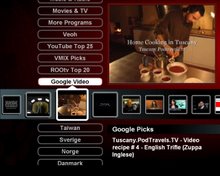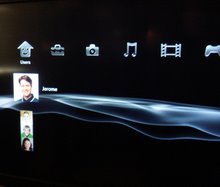Active-TV Ecosystem Developers,
The Issue: Video entertainment upstarts plan on using internet distribution to reach an audience.
Background: Established video broadcasters unlikely to grant free access to the living room TV.
Behind the scene: active-TV technology is capable of granting video distribution to the highly-prized living room audience via a multi-purpose application of the familiar Set-Top Box.
A frequently reported digital convergence analysts, Rob Enderle, implied in a recent article that active-TV technology “is licensed to third parties” by AMD. In fact, AMD does not license any active-TV technology. More correctly, there are several companies offering active-TV technology components. A Set-Top Box (STB) or TV developer is able to select from a variety of suppliers, depending on the particular set of features they wish to enable. In short, there is no single supplier of active-TV technology.
Interestingly, Enderle goes on to say that active-TV technology is “far more complete than Apple TV” and also “AMD has less control over the finished product”. I agree. In fact, since AMD does not license any of the technology, it is difficult to see how it would have any control over other companies’ active-TV based product. Enderle’s statement about active-TV being “complete” likely refers to its neutrality and accessibility when delivering video to the TV.
Active-TV technology tries to bring the openness of the PC-web to TV-web channel viewing. This is described as “painfully complex making this offering more difficult to sell even though it may actually provide one of the better values”. As PC users know, accessing the familiar PC-web can be complex; there are few regulations and imposed standards or quality assurance, but it is open to everyone. Active-TV technology brings these same problems and benefits to TV-web viewing.
Active-TV technology has been described as a step towards glasnost TV via networked-delivered video. It is also a relatively inexpensive approach, as it utilizes an already familiar or available ecosystem of components. However, its openness does not bring any assurances of TV channel quality. In fact it is so open that anyone who can build a blog or a PC-web page can also build their own TV-web channel. The currently closed Apple TV approach is much more restrictive, but Apple can better control the quality of the accessible video materials.
The informed Enderle goes on to described active-TV technology “as the most opposite to Apple’s, harder to use and not as attractive or as well marketed but with massive amounts of content including over-the-air broadcast support and no lock-in to any one content provider or hardware company. Call it maximum flexibility with the possibility that one of the licensing vendors will create an ease-of-use experience and market it so that its technical advantages over Apple TV could result in stronger sales numbers.”
Barriers to reaching the TV
For a long time I have heard the question (particularly in the US), why should the established broadcasters open their network (or associated STBs) to channels from other sources. It is suggested that executives at established channel suppliers, or even the IP-TV start-ups led by MBAs, want control over the video and any associated advertising. They may allow TV-web channels to enrich the content they already offer, but glasnost TV only suits the end-user.
Active-TV technology can equally be applied to closed systems; where video and TV-web channels are only accessible from a service provider’s portal. This principle could equally be applied to PC-web access, but there is no history of filtering URLs to restrict PC-web access. There is a long history of technical and marketing barriers to video entertainment in the living room. Will the freedom of PC-web access finally come to the TV? Or, will the old closed-system rules continue to survive the introduction of active-TV technology and the streaming of internet video to the living room?
My answer is that PC users are going to get a taste for PC-web video from companies like: Vmix, Veoh, UGO, Joost, Brightcove, NarrowStep, Babelgum and many more. Once users have experienced the freedom and variety of unrestricted TV-web channels, it is going to be hard to keep them satisfied with service from only self-serving portals. Users are initially going to experience TV-web channels from low-cost active-TV enabled TVs, Set-Top Boxes and networked game platforms – such as the Sony Playstation 2 - all quite easily purchased in retail stores. There are sufficient numbers of companies who just want to make money from selling an attractive hardware platform. Using active-TV technology immediately makes these boxes increasingly attractive and solves the hardware developer’s problem of demonstrating access to interesting video material.
Other approaches
As to other approaches to bringing internet-based video to the home viewer, a recent NY Times article describes a new IP-TV Box, which uses peer-to-peer (P2P) sharing to deliver video more efficiently. The Vudu box does not support active-TV technology, and works with a video portal service. The expected box cost is close to that of the Apple TV. These systems are closed-service systems, but as Odyssey’s Donatiello quoted in the NY Times states “You have to get the content to the television.” A PC-in-the-living-room approach has been largely rejected by home users. Digital Media Adapter (DMA) alternatives, such as Vudu and Apple TV, have yet to gain widespread acceptance. But the important objective is to deliver video to the living room and as the NY Times states “Steve Jobs at least, understands that”. Closed system boxes do allow the user to view video on the TV, but only video from the box providers approved sources. They don’t allow for widespread competition among TV-web channel suppliers. They are also not typically not multi-function boxes, which leads to cost and consumer acceptance issues.
Beyond a PC audience
YouTube is the video sharing site most talked about. It is famous for its short-format video. Now there are other companies like Joost who seek to make their mark in the same space. A critical differentiator may be support for increasingly longer-format and higher quality video from professional or semi-professional creators. This will put increasing pressure to make the same video available at the TV and not just the PC. The leaders in this new space may be those who first gain user approval at the TV location. There is a need for an open approach which enables TV-web channel developers to compete for viewers at the TV location, without having to first be granted approval from established broadcast suppliers or their STB providers. Active-TV technology provides this significant step towards glastnost TV.
A recent Wired article states the Joost vision as “universal TV, running on a hybrid P2P platform”. They also plan to exploit PC-based P2P video transfer efficiencies; But this is just PC-web, since without access to living room hardware such as Apple TV or an active-TV STB, there is no reaching the TV. To their credit, the Joost founders have successfully applied Skype’s VOIP technology to open-up a difficult to penetrate phone service business. Wired states an old Silicon Valley saying: “don’t bet against the internet”. And anticipates the Joost (Skype) founders might retort with the following corollary, “don’t bet against the Vikings”. Active-TV technology, interestingly, has every bit as strong Viking roots as Joost.
Ecosystem technologies
There are other emerging technologies helping to connect the home PC with the internet and a networked-STB. Orb software enables internet video to be transferred via a PC to the living room TV. Interestingly, it could also be used to send video in the other direction, out from the STB, in very much a Sling box manor. As discussed on the web, this is useful technology; particularly when distributing videos to portable player devices or micro-browser platforms like the Wii. But the TV UI is built by the Orb software. This can enable TV access to YouTube video, but the limitation is that the TV UI is not provided from a remotely access TV-web URL. Orb recently announced support for an active-TV enabled networked STB from Scandinavian based STB developer, Futarque. The Orb software and TV UI are browser based. In the Futarque case, the Orb TV UI runs on the PC and active-TV technology delivers the TV UI to the networked STB location.
Also of interest is TVersity which is currently working on an active-TV formatted TV UI for video streams distributed via RSS feeds. Like, Orb technology, there is also support for video reformatting before sending-on from the PC to the TV. This useful technology allows a user to subscribe to a TV-web RSS feed. At the TV, the latest video supplied by the RSS feed appears in the TV-web channel listings. Again, this is useful technology when forwarding video to a cell phone or PSP, but it does not give complete control over the TV-web channel’s User Interface (UI), which is possible via a TV-web channel directly formatted for active-TV. An interesting combination of these technologies would be a networked accessed active-TV UI which is also continually updated from an RSS video feed.
A low-cost and glasnost solution
There is a struggle by large and small companies alike to gain a significant position in video delivery to the home over the internet. This is fueled by the widespread acceptance of broadband service and home networking. Cost, technical and marketing barriers and partisan interests have focused current efforts on video sharing at the PC via PC-web. Active-TV technology is ideal for now moving the struggle to the living room TV location, or to any TV in the house.
Feedback, corrections and comments welcome.
Daniel Mann
Navigate YouTube available at iTunes App Sore
An easy to use iPhone and iPod touch App that enables both new and advanced YouTube users to get the best from YouTube.
Browse video Standard Feeds, Categories, Channels and Playlists. Then organize new videos into your own favorites and playlists. Make playlists private or public. Subscribe to other user's playlists and video collections for future viewing. Subscribe to videos matching search-words.
Look at publicly viewable favorite videos, playlists and subscriptions based on your YouTube friends, family and contacts. Send and receive video links with YouTube contacts via YouTube video messages.
Search for new videos tagged for your language or geographical region, using local keyboard. Explore for new videos via easy switching of user ID to the owner of interesting videos - then explore their world.
All actions are kept in sync with PC, Mac or Apple-TV access to YouTube. Available at Apple App Store.
Browse video Standard Feeds, Categories, Channels and Playlists. Then organize new videos into your own favorites and playlists. Make playlists private or public. Subscribe to other user's playlists and video collections for future viewing. Subscribe to videos matching search-words.
Search for new videos tagged for your language or geographical region, using local keyboard. Explore for new videos via easy switching of user ID to the owner of interesting videos - then explore their world.
All actions are kept in sync with PC, Mac or Apple-TV access to YouTube. Available at Apple App Store.
active-TV technology for PC

Windows PC based home network
Subscribe to:
Post Comments (Atom)








No comments:
Post a Comment